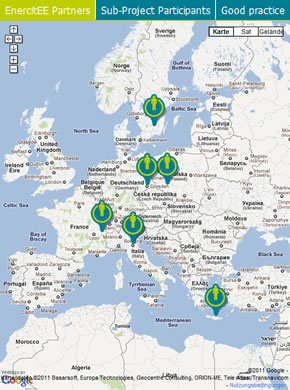Study visit of Lower Silesian local and regional policy makers to Bologna, Emilia-Romagna (Italy)
On 21-23 October 2013, the capital of Italian Emilia-Romagna region, Bologna, was visited by 17 policy makers representing local and regional authorities in Lower Silesia. The visit, which was organised as an activity of the EnercitEE project, was aimed to get to know local good practices and exchange experiences in the field of energy efficiency improvement.
Polish participants were presented with a brief description of the region and its current economic and social situation. Emilia -Romagna is a densely populated (4.4 million people with more than 22 000 km2) and well-developed Italian region, with strong industry (automotive, packaging, ceramics and food) and agriculture. Although it ranks among the richest regions in the European Union, it is currently facing the global crisis, which is reflected primarily in increased unemployment. Emilia-Romagna, like other Italian regions , has always been active in the field of energy efficiency and use of renewable energy sources. It is enough to say that in the popular European Covenant of Mayors initiative, which brings together local and regional authorities voluntarily committed to taking action to reduce CO2 emissions in their area, there are 128 municipalities from the region (for comparison, there are two municipalities from Lower Silesia, all Polish are 35). Therefore, it seems a perfect place to watch interesting solutions.
The first part of the visit was a small biogas plant located in San Giovanni in Persiceto, a town not very far from Bologna. This pilot installation produces biogas from locally available maize silage which is then upgraded to biomethane. The generated gas is then pumped into the national gas grid or used as fuel in vehicles. Biogas plants of this kind can heavily rely on subsidies in Italy (such as Feed-in Tariff), which makes the investment profitable. Specifications: 500 m3/h of biogas produced (process temperature of 55°C), 1.2 MW installed power (only 0.9 MW used), consumes annually about 18,500 tons of biomass (mainly maize silage and agricultural by-products), the cultivation area of about 340 hectares.
The participants then visited one of the largest waste incineration plant in Italy, operated by a municipal company HERA. This modern incinerator meets even the most stringent EU regulations and requirements regarding emissions of harmful substances into the atmosphere. Extensive monitoring system continuously monitors all operating parameters and displays them on a dedicated website available for everybody. Completely rebuilt and modernized in 2005, the plant has two independent lines, each of which processes 300 tons of mixed municipal and special waste (including hazardous) per day. Heat recovery is made possible by the operation of a special cogeneration station. 130 million kWh of electricity (serving 50 000 households) and 30 million Mcal of heat (serving 3 000 households) produced annually is then transmitted to the national grid and district heating system. Yearly production of thermal and electrical energy from waste equals to about 37,000 tons of heating oil, which would have to be burned. The plant serves as a fine example of a technologically advanced cogeneration plant, providing very much needed energy to the local population but also utilising the problem of waste.
The next point in the agenda was visiting the urban exhibition centre to see the current energy efficient solutions in the building industry and tour of the energy-efficient student building (a dorm), which, for the most part of the year, covers its demand for electricity and heat with its own resources (installed photovoltaic panels and heat pumps, the specific structure typical of passive houses). The building also houses cafeteria, a fitness room, a reading room, laundry and other facilities.
Finally, the program of the study visit was met with great interest from Lower Silesian local and regional authority representatives, who often discussed the presented sites and solutions in details. They also emphasized the need for more such events. After all nothing is so inspiring as watching others.










